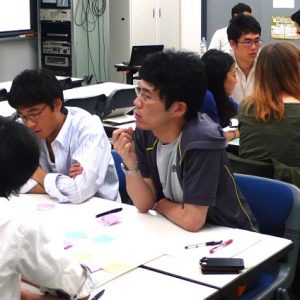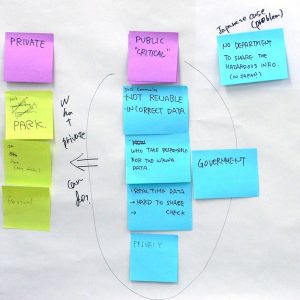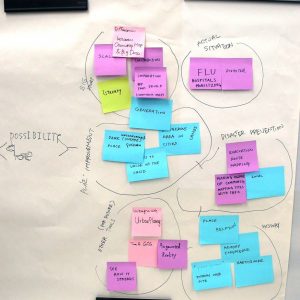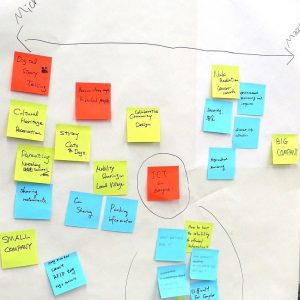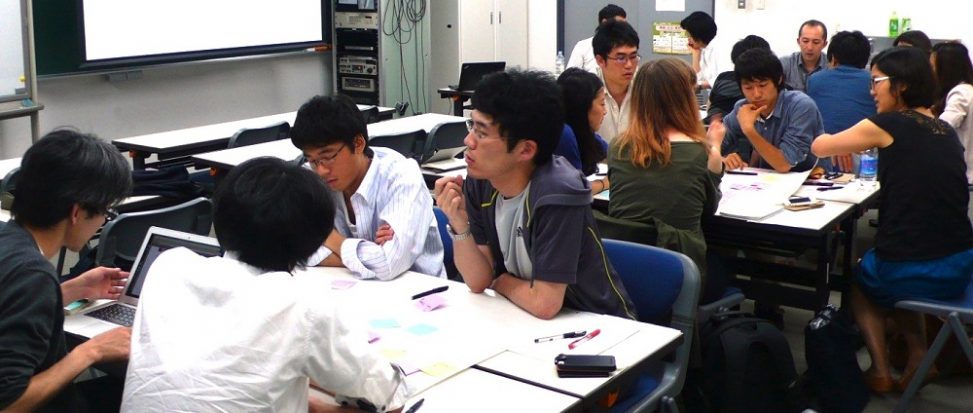
Public Private Partnership: Online Mapping and Community Participation in Flood Damage Control
The primary purpose of「Urban × ICT」workshop is to offer opportunities for graduate students of the Department of Urban Engineering and the School of Information Science and Technology not only to obtain interdisciplinary perspectives but also to apply them to tackle issues of natural and built environments.
Most cities in Asia are exposed to flooding every summer and the number is growing. The city of Seoul, South Korea is not the exception. Recently, the municipal government has launched an online community map, which does not only function as a device to control flood damage but also serve as a tool for promoting civic participation. On top of that, the project is jointly carried out by a public-private partnership.
Mr. Byung Hyun, Yang, our guest lecturer, brings out the process of prosecuting the community online map including his long-continued process of negotiating with the private sector. In「Urban × ICT 02」, Mr. Yang and participants further discuss and exchange issues around community map, partnership with private sector and big data.
概要
Urban × ICTシリーズ第2回目は、「水害」をキーワードに韓国ソウル市役所より専門家の梁炳賢氏を招聘し、海外の都市環境で実際にどのようにICT技術が使われ、人々の役に立っているのか、現場の話を体験してもらおうという企画としました。
毎年夏になると、アジアの各都市では「水害」との戦いが繰り広げられます。ソウル市もその例外ではありません。そういう状況の中、ソウル市では官民協力のプロジェクトとしてオンライン水害コミュニティマップを構築し、運営しています。このオンラインマップは市民がスマートフォンやソーシャルメディアを使って通報するだけに留まらず、通報に対する対処なども確認できるようになっています。
今回は、オンラインコミュニティマップの構築背景や運営に関するお話を聞くだけでなく、コミュニティマップの課題や今後のあり方について東京大学のそれぞれ専門の違う学生達と海外の専門家が意見を交える場となりました。
後半のテーマディスカッションでは、「マイクロジオデータの登場が研究やビジネスをどのように変えていくだろうか? また、そのようなデータを扱う上で持つべきスキル、気をつけねばいけないことは何か?」というテーマで、GCLメンバーと他の参加者が議論、各グループのアイデアをお互いに発表しあいました。一例を挙げと、現状いかなる分野でどのようなマイクロジオデータが利用可能であるのか、今後どのようなデータが利用できるようになりそうか、また、利用できると役に立つのか、といったことを整理しました。また、マイクロジオデータはその空間的分解能の高さゆえ、プライバシー上の問題も懸念され、その取扱いには十分注意する必要があるといった重要な点に着目した意見や、研究やビジネスにおいて、本当に必要な部分を取り出して扱うためのスキルが必要になってくるのでは、といった観点からの意見も挙げられていました。終了後も、GCLメンバーなどからコメントシートに多くの質問が投げかけられました。
プログラム
| 40min | Lecture | |
|---|---|---|
| 10 min | Q&A | |
| 40min | Group Discussion | |
| 30min | Group Presentation + Q&A |
Workshop Highlight
Following that students are divided into three different groups and take part in the group discussion.
Group A
Members: 林相熏 奥田朋仁 関口達也 寺口敏生
The member of group A consists of four: three members are currently majoring in data analysis while one student is specialized in international development planning. The group begins their discussion by stating the problem that there is no government organization sharing information on hazardous materials in Japan. Then the group goes on to the issues and the limits currently in place in the public sector data sharing. The group concludes their discussion that the private sector might be able to help the public sector to overcome such limits.
Group B
Members: 越村高至 瀬川明日奈 道喜開視 Ilji Cheong Katarina Ringenson
In the case of group B, all group members are from the field of Urban Planning, particularly specialized in Urban Design. The group comes up with many and different ideas and sort them out in six different categories; they are not mutually exclusive. In the beginning, the group establishes a possible disaster situation that would need community map and big data. Based on the given situation, the group tries to tackle the question by examining issues from different perspectives: e.g., history, place improvement and disaster prevention. Lastly, they propose further suggestions in the public sector data sharing such as a network oriented, ICT-based urban planning.
Group C
Members: 葛杭麗 金智恩 高梨遼太郎 彰暁障 水越伸
The member of group C is composed of diverse academic backgrounds such as Media Studies, Urban Planning and Computer Science. The group begins the discussion by taking a stance that ICT should be for everyone. Their keywords cover from small to large scale social factors such as people with special needs and environmental monitoring. All presented ideas are engaging with ICT. Then the group concludes by identifying the possible challenges to achieve the partnership between the public and private sectors in the data sharing.
Conclusion
The workshop was challenging in a couple ways: firstly, the topic of the workshop and the question for the group discussion are not familiar ones for most of students. However, they put efforts in communicating and exchanging ideas not only with their group members and fellow students but also with the guest lecturer. Secondly, brainstorming and shaping ideas in forty minutes are not an easy task, especially when students are not familiar with the topic. Nevertheless, students did shape their answers in such a short period of time.
| 開催日時 | 2013.5.27 |
|
|---|---|---|
| 場所 | 東京大学工学部14号館 145講義室 |
|
| 参加者・人数 | 14 graduate students and researchers in total from the Department of Urban Engineering and the School of Interdisciplinary Information Studies. |
|
| 講師/ファシリテーター | ゲスト ファシリテーター |
原稿執筆:宋知苑



